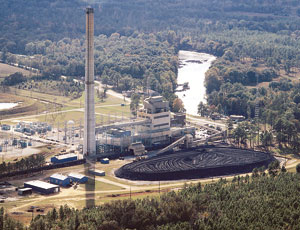At least three electric utilities are seeking to retrofit aging coal-fueled plants to burn biomass in order to keep costs down, meet renewable portfolio standards and avoid having to comply with new emissions rules. “A lot of these coal plants are entering the twilight of their years,” says Dave O’Connor, manager of combustion performance for the Electric Power Research Institute, Palo Alto, Calif. Repowering “is much cheaper than building a new greenfield plant and is a very cost-effective way to give them a new purpose.”

O’Connor has been working closely with Georgia Power Co., Atlanta, which last month received permission from the Georgia Public Service Commission to spend $103 million to convert a 164-MW coal-fired unit at its Plant Mitchell, near Albany, Ga., to a 96-MW wood-fired biomass plant.
In February, Minneapolis-based Xcel Energy asked the Wisconsin Public Service Commission to approve a $58-million project at a 20-MW coal-burning unit of its Bay Front Powerplant, Ashland, Wis., to install biomass-gasification technology that would use wood for fuel. Ontario Power Generation, Toronto, also is investigating availability of biomass to convert its four coal plants.
Interest in 100% coal-to-biomass conversion has grown rapidly, says Edward Gray, principal of Antares Group Inc., the Landover, Md.-based engineering and development firm. Antares and Georgia Power did the feasibility study for Plant Mitchell’s conversion. The study found more than enough available wood waste.
Finding biomass is one of the biggest challenges, says Gray. “It’s not like you can put up a wind tower and test the wind. You have got to get out and find this material. It’s a complicated supply structure.” The size and cost of the conversions depend largely on the existing equipment and the needs of the company, Gray and O’Connor say.
Georgia Power’s conversion, beginning in 2011, will replace the bottom of the existing boiler with stoker grate technology, says Kenny Smith, project manager. Suspension firing will be added to the boiler, enabling the unit to produce an additional 24 MW of power. A lot of engineering has gone into ensuring that the wood particles—4 in. and smaller—can move through the coal plant safely.
“The last thing we want is fires and explosion,” O’Connor says.
Wood-handling systems will replace the coal-handling systems, and new drives will be added for the trucks bringing the one million tons of wood fuel to the plant. Right now, trains deliver 218,000 tons of coal per year. More biomass has to be burned because wood biomass has a Btu rate about one-third of coal’s.
When complete in 2012, the unit will provide baseload power. The unit now operates at 40% capacity. The company is doing detailed engineering in-house and will begin to develop specifications for a contractor later this year, says Brian Barham, EPC project manager for Southern Co., which owns Georgia Power.
Depending on Plant Mitchell’s success, Southern Co. may look at converting other plants. Despite the up-front costs of the conversions, Georgia Power officials say burning biomass will save its customers money due to lower fuel costs.
Xcel’s boiler doesn’t lend itself to direct burning of biomass, so the company will add an external gasifier, says David Donovan, manager of regulatory policy for Xcel. Work on that plant is expected to begin in 2010 and finish in 2012.
Burning biomass is considered “carbon neutral” if the biomass is from managed forests, because the carbon dioxide released in burning would have been released anyway by decomposing biomass.
The Southern Alliance for Clean Energy, Knoxville, Tenn., was a cheerleader for the Plant Mitchell conversion during PSC proceedings.
“These [biomass] facilities are a lower risk option, economically and environmentally, in the carbon-constrained world of today,” wrote SACE in comments filed with the commission. “Biopower is better...than other fuel types the company currently uses and is pursuing, including...coal...and...nuclear generation.”

Post a comment to this article
Report Abusive Comment